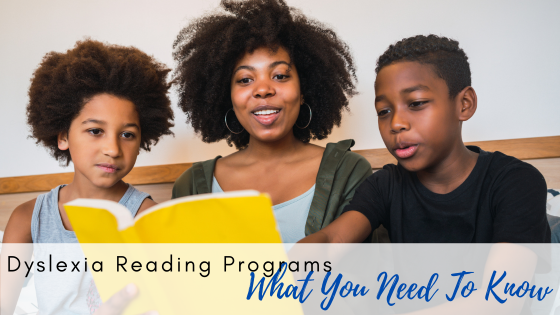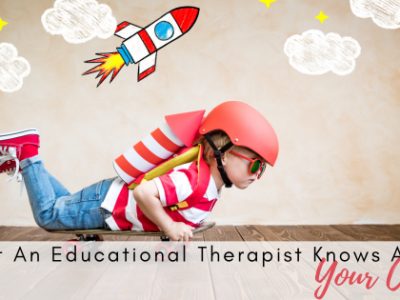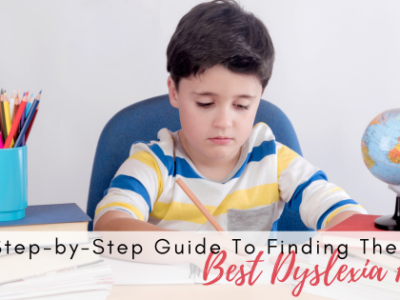
Dyslexia Reading Programs: What You Need To Know
When it comes to finding the best reading programs to help with your child’s dyslexia, checking out all of the options can be overwhelming. Seeking the most successful methods for your student is important, but there is just so much to navigate in the world of dyslexia reading programs. From the components of a successful program to the qualifications of instructors, there are plenty of details to consider. Read on to learn more about what you need to know about dyslexia reading programs.
Understanding dyslexia is key. Students with dyslexia have a neurodevelopmental learning difference, which affects how the brain processes language. Having dyslexia can affect certain essential parts of a student’s ability to learn language in several areas. Finding a reading program that addresses each of the following can be most effective:
- Phonemic awareness: This deals with distinguishing individual sounds within words.
- Phonics: Phonics involves mapping out the relationship between sounds and letters.
- Decoding: Decoding deals with sounding out written words.
- Fluency: Fluency has to do with students reading smoothly in the areas of accuracy, rate, and expression.
- Comprehension: Comprehension incorporates the ability to process written text, to understand its meaning, and to integrate the text with things that the reader already knows.
Structured literacy is important. When it comes to dyslexia reading programs, know that structured literacy programs are the most effective kind for students. Qualities of a well-structured literacy program include:
- Explicit: This kind of program directly teaches phonics and other reading skills like blending and segmenting, using a step-by-step approach. This helps to build a strong foundation for decoding unfamiliar words, which eventually also helps with fluency.
- Multisensory: Just like it sounds, a program that incorporates multisensory instruction engages multiple senses of the student in order to achieve a deeper level of learning. This can include visual, auditory, and kinesthetic learning activities. This can involve using manipulatives, movement activities, visual cues, and auditory feedback to help solidify a student’s understanding.
- Sequential: A sequential program will work to build skills progressively; this helps to ensure mastery before students move on to new skills.
- Individualized: A reading program that is tailored to a student’s specific needs is essential for success.
- Cumulative: Programs the work tend to build on skills and regularly revisit skills in order to maintain long-term retention.
Know what’s out there. There are many different options to explore for dyslexia reading programs, each with their own approach. Orton-Gillingham is considered by many to be the gold standard of dyslexia reading programs as this methodology tends to emphasize multisensory, individualized instruction.
Consider your student. It’s imperative that you take into account the individual learning style and needs of your student when choosing the best dyslexia reading program. Things to think about include: your child’s age, academic needs, the program’s alignment with structured literacy principles, the qualifications and experience of instructors, the cost of the program, as well as the availability and accessibility of the program.
Learn a little more about those who provide dyslexia help. Often, families tend to turn to reading tutors or classroom teachers for instruction. There is another option to consider for implementing dyslexia reading programs: dyslexia therapy. Dyslexia therapy at Dyslexia on Demand is offered exclusively by Certified Academic Language Therapists (CALTs). CALTs go through intensive training in order to ensure they meet rigorous standards. Some key benefits of working with a CALT include having expertise in the complexities of dyslexia, individualization to the child’s needs, a multisensory approach, evidence-based practices, and collaboration with the student’s community of learning.
In addition to a strong dyslexia reading program, think about additional aspects of learning. Finding the right reading program is just one part of your journey to help your student with dyslexia. It’s also important to advocate for your child in his or her classroom; ensure that your student is getting the right interventions and accommodations at school. Collaborating with teachers and tracking progress at school is key too. A positive and supportive environment—at home, at school, through the reading program—will help to foster a sense of accomplishment and inspire motivation in students.
Take a look at Take Flight Therapy. Dyslexia on Demand offers Take Flight dyslexia therapy, an Orton-Gillingham program which is a comprehensive intervention for students with dyslexia. This 2-year curriculum builds on the success of previous dyslexia programs including Alphabetic Phonics, the Dyslexia Training Program, and The Texas Scottish Rite Hospital Literacy Program. This program has been specifically designed for use by Certified Academic Language Therapists to help children with dyslexia who are ages seven and older. It has been developed to enable students with dyslexia to achieve and maintain better word recognition, reading fluency, and reading comprehension. This therapy also aims to aid in the transition from a therapy setting to a real-world setting.
Dyslexia on Demand only offers dyslexia therapy. Are you seeking a dynamic, effective program for your student with dyslexia? At Dyslexia on Demand, one-on-one or group therapy opportunities happen 4 times a week for students with a Certified Academic Language Therapist. Reach out to Dyslexia on Demand to learn more.







